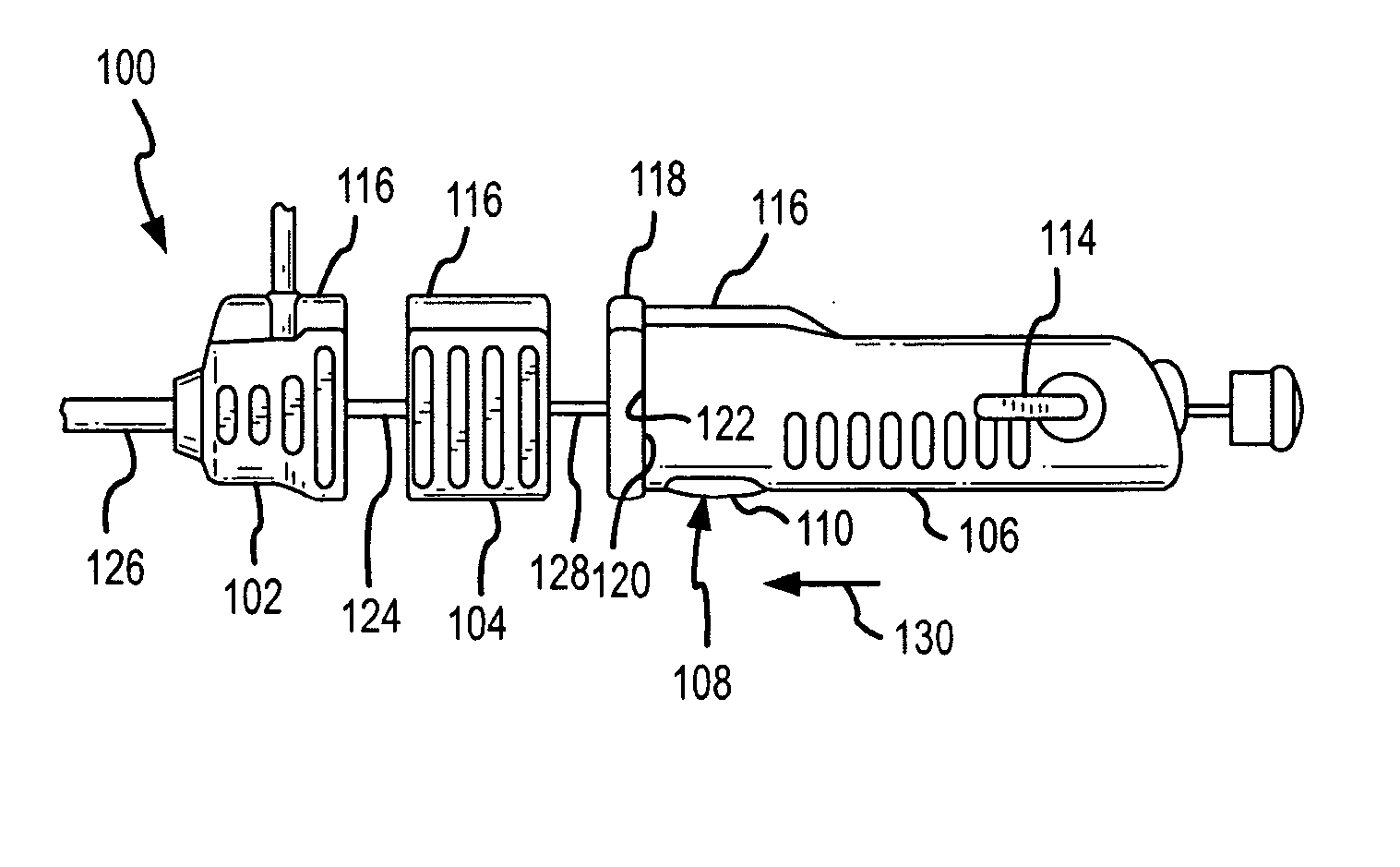Transseptal catheterization assembly and methods
a technology of transseptal catheter and assembly, which is applied in the field of transseptal catheterization assembly and methods, can solve the problems of difficult access to the left atrium through the pulmonary artery, difficult access to the left atrium with a catheter, and difficult access to the left atrium, etc., and achieves the effects of convenient advancement of the sheath, easy manipulation, and more stability and control
- Summary
- Abstract
- Description
- Claims
- Application Information
AI Technical Summary
Benefits of technology
Problems solved by technology
Method used
Image
Examples
first embodiment
[0057] For example, FIGS. 2, 3 and 4 identify an improved handle assembly in accordance with the present invention. The handle assembly has cooperating hub assemblies for the sheath 102, dilator 104 and needle assemblies 106 used in transseptal procedures. The hub assemblies of each of these components are preferably preformed having corresponding removably attachable locking mechanisms (not shown). The locking mechanisms include for example, spring or lever biased latches for removable coupling. The assembly further has a two-way adjustable valve 114 disposed within needle hub assembly 106. At least one of the hub assemblies further includes an orientation member 116, e.g., a fin, that serves to visually identify the orientation of the particular assembly inside the body and to help maintain the proper orientation of the members during a transseptal procedure. The configuration of the hub assemblies themselves may also be configured to allow for visual identification of the orienta...
second embodiment
[0060]FIGS. 5A and B identify an improved handle assembly in accordance with the present invention. The handle assembly 200 has cooperating hub assemblies for the sheath 202, dilator and needle assemblies 206 used in transseptal procedures. The hub assemblies of each of these components are preferably preformed having corresponding removably attachable locking mechanisms (not shown). The locking mechanisms include for example, snap-fit assembly, or spring or lever biased latches for removable coupling. The assembly further has a two-way or three-way adjustable valve 208 disposed within needle hub assembly 206. At least one of the hub assemblies further includes an orientation member 210, e.g., a fin, that serves to visually identify the orientation of the particular assembly inside the body and to help maintain the proper orientation the members during a transseptal procedure.
[0061] Additionally, the dilator hub 204 and the needle hub 206 are separated by at least one removable spac...
third embodiment
[0063]FIG. 6A-6C identify an improved handle assembly in accordance with the present invention. The handle assembly 300 has many similar features to those described in FIGS. 2-4. In addition, the handle assembly in 300 further includes two button-release assemblies 302, 304, one for removably coupling the sheath hub and the dilator hub and the other for coupling the needle hub to the needle stop mechanism 312. Alternatively, the needle hub 310 may comprise a ridge 314 (in this case an annular ridge) surrounding the distal portion of the needle hub, or any other structure that applies tactile resistance. This ridge 314 interfaces with the proximal portion of the needle stop mechanism 312 and serves to provide a temporary stop for the needle assembly 310. Thus, the assembly FIG. 6A is shown in the needle stop position. In use, the user inserts the needle assembly 310 to a desired predetermined position within the dilator 316 by pressing the assembly 310 forward until the ridge 314 mee...
PUM
 Login to View More
Login to View More Abstract
Description
Claims
Application Information
 Login to View More
Login to View More - R&D
- Intellectual Property
- Life Sciences
- Materials
- Tech Scout
- Unparalleled Data Quality
- Higher Quality Content
- 60% Fewer Hallucinations
Browse by: Latest US Patents, China's latest patents, Technical Efficacy Thesaurus, Application Domain, Technology Topic, Popular Technical Reports.
© 2025 PatSnap. All rights reserved.Legal|Privacy policy|Modern Slavery Act Transparency Statement|Sitemap|About US| Contact US: help@patsnap.com



